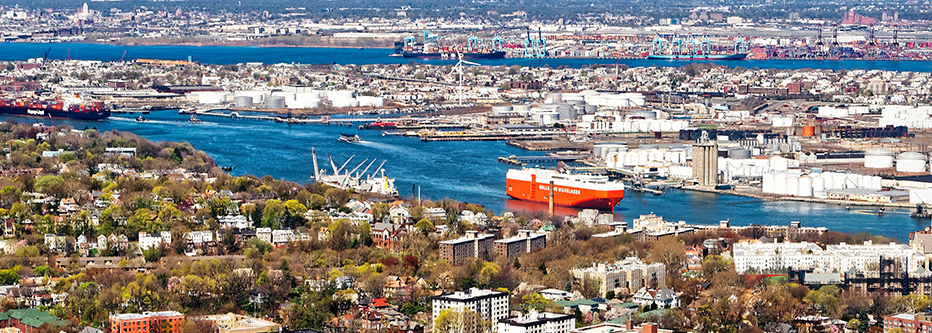
With the opening of the Erie Canal in 1825, New York Harbor became the busiest harbor in the Western Hemisphere. As the economy of New York grew, so did the vessels that served its port. Larger vessels required deeper channels. In 1899, the Federal government dredged the Ambrose Channel to a depth of 40 feet,[1] and in 1921, the Port Authority of New York & New Jersey was created through a compact by both states, further demonstrating that public sector investments were necessary to facilitate the movement of goods by water.
To this day, the country’s rivers, coasts and harbors continue to provide a valuable means of moving goods. Although barriers to the widespread adoption of marine highways persist, regional, state and local transportation decision makers should consider how they can complement our aging highway network and bring redundancy should disruptions arise. Jacobs understands the challenges to getting marine highways operating at scale, and can work with local transit and planning authorities, and the private sector to identify opportunities.
A breaking point
On Sunday, June 4, 2023, an elevated portion of Interstate 95 (I-95) near Philadelphia collapsed after a tanker truck carrying 8,500 gallons of fuel flipped and caught fire. This vital highway’s northbound lanes were immediately closed to traffic. According to local news reports, the affected highway area typically carries 160,000 vehicles and nearly 13,000 commercial trucks each day[2]. While crews have temporarily reconstructed six of the usual eight lanes, representing a decline in capacity of 25%, commercial truck drivers may need to find other ways to reach their destinations should congestion increase during the morning and evening peak hours. This shift to other routes increases congestion, contributes to air pollution and further strains the freight network. Moving trucks on barges across the Delaware River between New Jersey and Pennsylvania allows goods to move to and from the Philadelphia area with less strain and congestion than on alternate roadway routes.
Freight can’t wait
According to the Federal Highway Administration (FHWA), trucks carry about 70% of all freight by weight through the U.S. However, all e-commerce products travel in commercial trucks for their “last mile” delivery to our homes and businesses. Any disruption in the nation’s highway network slows economic growth. While there are legitimate concerns related to roadway safety and air quality, without the efficient movement of trucks, the national economy would grind to a halt. Thankfully, trucks can travel on highways and on ferries.
A solution to highway disruptions staring back at us
Public sector agencies responsible for planning, building and maintaining transportation infrastructure have increasingly looked toward more innovative ways of moving freight. Across the U.S., investments are being made to maritime infrastructure so that more goods can be moved by vessel or barge.
Officially named the United States Marine Highway Program by the U.S. Department of Transportation, moving goods by vessel or barge, often called “blue highways”, has numerous benefits, including:
- Providing redundancy should there be any disruptions along the road and rail surface transportation network.
- Creating and sustaining jobs on US vessels, and at ports and shipyards.
- Relieving surface transportation network congestion.
- Improving environmental sustainability of the U.S. transportation system by using less energy and reducing air emissions (such as greenhouse gases) when measured on a per ton-mile basis.
Finally, marine highways improve public safety and security by providing alternatives for moving hazardous materials away from heavily populated areas[3].
In the New York City region, shippers can use the “M-95”, a nod to the parallel I-95 highway. The M-95 stretches from Miami, Florida to Portland, Maine and spans 15 states connecting commercial navigation channels, ports and harbors. It also connects to the M-87 Route and the M-90 Route near New York City. In 2021, the Maritime Administration designated the Port Raritan Terminal Facility in New Jersey in recognition that there are untapped opportunities to ship goods via water from that terminal[4]. From Port Raritan trucks can drive onto a ferry destined to New York City, thereby avoiding I-95.
The challenges that lie ahead
Each mode of freight transportation offers advantages and disadvantages, and all are integral in the nation’s freight network. For example, freight rail excels at moving a high quantity of low value freight (e.g., aggregate) over long distances (more than 250 miles), while air cargo excels at moving a low quantity of high value goods (e.g., high end fashion, electronics, medical supplies, fish products).
The biggest impediment to getting marine highways off the ground and into the water is the competition with trucking to move freight. Trucks are inherently nimble and can go almost anywhere, at any time, because of the nation’s highway network. Other factors like the availability of waterside landings, high fuel and labor costs and the strength of currents and the unpredictable “roughness of the seas” also reduces the proliferation of marine highway services. Nevertheless, marine highways still add redundancy to a freight system that seeks to reduce, or eliminate, any potential disruption.
Our work
Building upon this concept, Jacobs developed a process using StreetLight Analytics to identify the origins and destinations of trucks moving goods between southern New Jersey and Philadelphia, Pennsylvania and Wilmington, Delaware. Jacobs identified a critical mass of daily truck movements, indicating a real market potential for diverting trucks currently crossing the Delaware River from the regional highways and bridges to barges. This alternative provides daily operational and economic efficiencies to the trucking industry and reduces the daily wear and tear on roads and bridges, lessening long-term maintenance costs.
This potential marine highway system, which Jacobs is supporting, is envisioned to be similar to the movement of trucks across the Hudson River between Port Raritan in New Jersey to multiple landing points in New York City, with the Port Raritan facility currently in the preliminary engineering and permitting phase.
Through these investments, the private and public sectors continue a long tradition of supporting maritime commerce. In the 19th and early 20th centuries, the country made investments in maritime infrastructure because there was no highway network. Today, the public sector can continue that tradition, not because of the lack of highway infrastructure, but because the need for redundancy given the growth of our increasingly interconnected, time-sensitive supply chain.
Jacobs can help you identify marine highway opportunities and deliver efficient and sustainable operational, infrastructure and financial solutions today!
About the authors

Ryan White, AICP leads Jacobs’ New York transportation planning group. While working at the NYC Economic Development Corporation (EDC), he helped create the North Atlantic Marine Highway Alliance (NAMHA). Ryan also worked with the Port Authority of New York & New Jersey to designate the “New York Harbor Container and Trailer on Barge Service” between New Jersey and Red Hook, Brooklyn. Approved by the Maritime Administration (MARAD), the designation led to a $1.6 million U.S. DOT grant for infrastructure to improve barge operations and create a crane operator training center that improves safety and container throughput.

Scott Parker, PE, leads Jacobs’ New Jersey transportation planning group. He was instrumental in applying for and securing Maritime Administration (MARAD) funding alongside the New Jersey Department of Transportation and Federal Business Centers. Inc. for preliminary design and environmental permitting of the Port Raritan wharf’s planned rehabilitation and conversion to a truck-on-barge terminal.












































